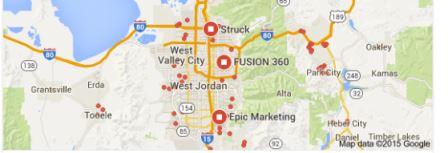While the digital marketplace continues to replace traditional brick-and-mortar stores at a rapid rate, there’s no denying that for most businesses (especially local companies), having a physical location where customers can find you remains an important part of achieving business success. But how does this play out in the digital landscape?
After all, there is more than one way to get customers to find your business online. Apps like Google Maps and directory sites such as Yelp are a too-often neglected part of SEO and content marketing strategy, but may ultimately be the key to driving new customers (in some cases quite literally) to your business.
This is something that should be addressed both on-site and externally to ensure the best possible results. For example, most Web development programs provide the option to include a Google Maps widget on the site, which allows users to open up the location in Google Maps and then get directions to the location. Another popular option is to include a screenshot of the business’s location next to the address and other important contact information (such as in this example from Fusion 360).

However, perhaps even more important than including such information on-site or installing a Google Maps widget is off-site maps optimization. As Search Engine Land explains, searches for local businesses often tend to be crowded with results from Google Maps, Yelp and other directory sites before organic search results begin filtering in. For example, let’s look at these screenshots from a Google search for “ad agency Utah.”


Note that after the paid search results, results from Google maps appear, listing agencies that have a Maps listing through Google My Business. And even after that, the first organic search result is for a directory site.
What does this mean for small businesses? Quite simply, if you aren’t including a Maps listing as part of your SEO and content marketing strategy, you are potentially missing out on a significant chunk of your business. So how do you go about optimizing your off-site Maps listing to improve the return on your digital marketing investment? Here are a few important steps.
Use and Optimize Google My Business
In order to claim your business location on Google Maps, you first need to set up a Google My Business account. This free account allows you to either create a location listing for your company or claim an existing location that someone else has already entered. And without this account, there’s no way to get your business listed on Google Maps in the first place.
There’s more to this than simply plugging in a business name and address, however. Google Maps locations can be incredibly detailed, and the more information you provide in your listing, the better that listing will rank on Google Maps results and the more useful it will be to your potential customers.
Basic information such as the category your business belongs to, business hours, phone number and your website are great places to start (and will certainly help customers), but Google My Business also allows users to add photos to provide potential customers with a greater idea of the location’s offerings.
Google My Business also allows companies with multiple locations to manage multiple sites from a single account. If you need to add more than 10 listings, a spreadsheet file can be created and uploaded to ease the process (see this article for more detailed information on this process). Sometimes, a duplicate or “closed” listing will also appear for your business because of information that others have put into Google’s system. It is important to merge or delete such listings to avoid negative ranking influences.
After submitting your information, be sure to request a verification PIN code. Google will send a postcard with the code to your business address (typically in about two weeks) that you will then need to add to the business listing to have it verified on Google Maps. This is extremely important, because without the verification, your listing won’t show up on Google Maps.
Claim and Optimize Other Directory Listings
Webologist notes that there are several other directory sites that can play an important role in helping customers find your business online. Yelp is a highly authoritative site that is primarily used by customers to leave reviews of a business, but business owners can also claim their location listing and include similar information to what would be inc luded in a Google Maps listing. Angie’s List and Foursquare are other useful directory and review sites where businesses can claim and update a profile with accurate and helpful information.
luded in a Google Maps listing. Angie’s List and Foursquare are other useful directory and review sites where businesses can claim and update a profile with accurate and helpful information.
Other business directories, such as YellowPages.com (yes, the Yellow Pages still exist) are also good locations for getting your company’s address, phone number and website listed. Businesses would do well to also look into getting their business listed with specialized local directories related to their industry (such as the Utah ad agencies directory site previously shown). Social media can be another great location referral source, as Facebook Pages allow businesses to share their address, phone number, website and even e-mail contact information.
Another potential benefit (or drawback) of many of these sites is the ability of consumers to leave reviews of the business. While more reviews can provide increased visibility on Google Maps or Yelp, an overwhelming number of negative reviews will almost certainly drive business away rather than attract it. As a business owner, it is important to monitor this feedback and respond to it.
Be careful in responding to negative reviews and use them as an opportunity to demonstrate your dedication to customer service, rather than giving in to the temptation to leave a snarky response. And in some instances, it may be a good idea to look into those negative reviews and see if there are things your business needs to improve.
Don’t Forget About Other Content Marketing Influences
Creating and optimizing listings on Google Maps, Yelp and other directory sites are important, but this shouldn’t leave other elements of content marketing strategy in the dust. Even the nicest Google Maps entry won’t appear at the top of those listings without some serious content marketing and SEO work supporting the connected URL.
Optimizing your website’s content to be relevant to the localized target market with keywords, useful titles and page headings and optimized images also play an important role in improving your SEO ranking, while generating useful articles and other content for publication both on your own site and on third-party sites help further build rapport with Google. And these on-going elements of digital marketing should certainly not get left behind as you attempt to beef up your presence on Google Maps.
Optimizing your locations on Google Maps and other directory sites should be done in support of your overall content marketing strategy, not instead of it. This way, as your other content marketing efforts bear fruit, your business will rise in search results—not only in organic rankings, but also in the surprisingly important rankings of Maps results.
Digital & Social Articles on Business 2 Community(147)
Report Post




